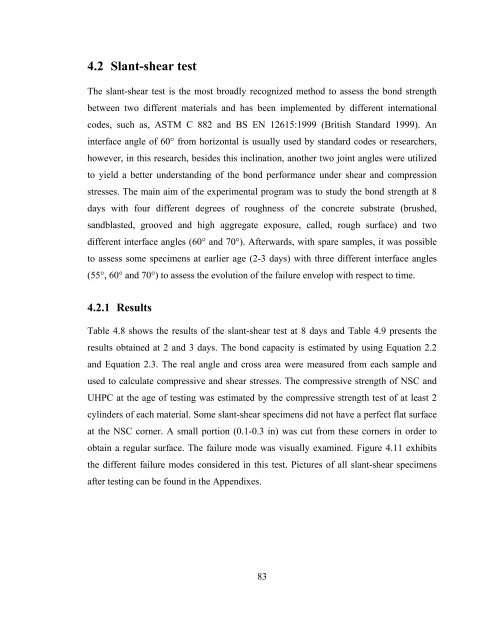compatibility of ultra high performance concrete as repair material
compatibility of ultra high performance concrete as repair material
compatibility of ultra high performance concrete as repair material
You also want an ePaper? Increase the reach of your titles
YUMPU automatically turns print PDFs into web optimized ePapers that Google loves.
4.2 Slant-shear testThe slant-shear test is the most broadly recognized method to <strong>as</strong>sess the bond strengthbetween two different <strong>material</strong>s and h<strong>as</strong> been implemented by different internationalcodes, such <strong>as</strong>, ASTM C 882 and BS EN 12615:1999 (British Standard 1999). Aninterface angle <strong>of</strong> 60° from horizontal is usually used by standard codes or researchers,however, in this research, besides this inclination, another two joint angles were utilizedto yield a better understanding <strong>of</strong> the bond <strong>performance</strong> under shear and compressionstresses. The main aim <strong>of</strong> the experimental program w<strong>as</strong> to study the bond strength at 8days with four different degrees <strong>of</strong> roughness <strong>of</strong> the <strong>concrete</strong> substrate (brushed,sandbl<strong>as</strong>ted, grooved and <strong>high</strong> aggregate exposure, called, rough surface) and twodifferent interface angles (60° and 70°). Afterwards, with spare samples, it w<strong>as</strong> possibleto <strong>as</strong>sess some specimens at earlier age (2-3 days) with three different interface angles(55°, 60° and 70°) to <strong>as</strong>sess the evolution <strong>of</strong> the failure envelop with respect to time.4.2.1 ResultsTable 4.8 shows the results <strong>of</strong> the slant-shear test at 8 days and Table 4.9 presents theresults obtained at 2 and 3 days. The bond capacity is estimated by using Equation 2.2and Equation 2.3. The real angle and cross area were me<strong>as</strong>ured from each sample andused to calculate compressive and shear stresses. The compressive strength <strong>of</strong> NSC andUHPC at the age <strong>of</strong> testing w<strong>as</strong> estimated by the compressive strength test <strong>of</strong> at le<strong>as</strong>t 2cylinders <strong>of</strong> each <strong>material</strong>. Some slant-shear specimens did not have a perfect flat surfaceat the NSC corner. A small portion (0.1-0.3 in) w<strong>as</strong> cut from these corners in order toobtain a regular surface. The failure mode w<strong>as</strong> visually examined. Figure 4.11 exhibitsthe different failure modes considered in this test. Pictures <strong>of</strong> all slant-shear specimensafter testing can be found in the Appendixes.83
















